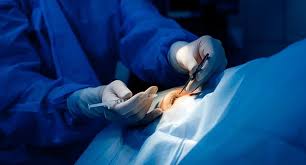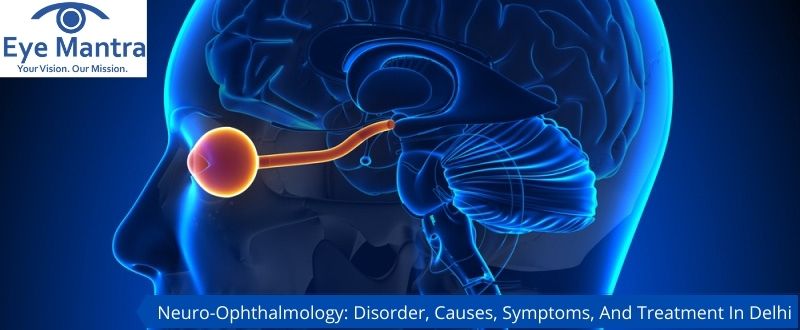Contents
Neuro-Ophthalmology Disorder
Neuro-Ophthalmology is a specialization focusing on neurological problems related to the eye. We all have studied in our school how the human eye captures the visuals it sees. Transmitting to the brain to be resolved as images through the optic nerve. And any dysfunction of this nerve may cause visual impairment and could even lead to irreparable damage. This field is an amalgamation of Neurology and Ophthalmology. The field of Neuro-Ophthalmology enables the diagnosis and management of complex systemic diseases of the nervous system that affect vision, eye movements, and alignment, as well as pupillary reflexes.

Types of Neuro-Ophthalmology Diseases And Their Treatment
There are various types of eye related problems that can be treated under the specialized field of neuro-ophthalmology.
Optic Neuritis
This disease involves inflammation of the optic nerve, a bundle of nerve fibers that transmits visual information from your eye to your brain. This inflammation could occur due to various reasons. Ranging from an infection to an autoimmune disorder. There is a sudden loss or decrease in vision due to the inflammation. Optic neuritis is often linked with Multiple Sclerosis (MS). The common symptoms of optic neuritis include pain and temporary vision of loss in one eye.
Signs and Symptoms of Optic Neuritis
- the first indication of MS
- infections
- immune diseases such as Lupus.
Most people can quickly recover from a single episode of optic Neuritis and restore their vision. Treatment with steroids may speed up the recovery after Optic Neuritis.
Treatment for Optic Neuritis
In most cases, the condition does not require any treatment and goes away on its own. To ensure a fast healing procedure, your doctor may prescribe some high-dose steroid drugs through an IV. This treatment also helps in lowering your risk of other MS problems or delay their start. However, these drugs do not help in improving your vision.
In such cases, your doctor would suggest other treatments including:
- Intravenous Immune Globulin (IVIG): This treatment is also known as Plasma Exchange that uses blood as a medicine. During the treatment, medicine is injected into the patient’s veins. It is a long-term treatment that is preferred to subside severe symptoms. Neuro-ophthalmology treatment is preferred for those whose brain MRI shows lesions.
- Vitamin B12 shots. This treatment option is rarely used for those having deficiency problems.
If your optic neuritis results from a disease, your doctor will treat that condition.
Papilledema Neuro-Ophthalmology
Papilledema is a serious medical condition where the optic nerve becomes swollen. Some of the symptoms may include visual disturbances, headaches, and nausea. In Papilledema, the optic disc swells due to excessive pressure inside the skull. That may be because of a brain tumor, head trauma, bleeding in the brain, infections such as meningitis, encephalitis, and more.
It is difficult to identify the cause of Papilledema Neuro-Ophthalmology because some of them can be life-threatening. It can occur in one or both eyes. Treatment of Papilledema will vary according to the cause.
Treatment When Papilledema Is Caused By IIH
In the case of IIH, Idiopathic Intracranial hypertension, which is a rare condition where the body produces too much cerebrospinal fluid. This leads to increased pressure in the brain. It may be treated by weight loss (Online Weight Loss), a low-salt diet, and medications, such as acetazolamide, furosemide, or topiramate. Surgery is only considered when lifestyle changes and medications fail to help.
Treatment When Papilledema Is Caused By Tumors, Head Injury, or Infection
Such underlying conditions will demand more serious treatment. For example, a brain tumor, bleeding within the brain, a blood clot, or some other brain condition would require surgery.
The type of surgical procedures used will depend on the conditions they need to rectify.
On the other side, infections are usually treated with antibiotics or antiviral medications.
Treatment when Papilledema Is Caused By High Blood Pressure
In some rare cases, papilledema is caused by extremely high blood pressure, for example, more than 180/120. When a person’s blood pressure has reached this high, it is known as a hypertensive crisis and requires critical emergency medical care. Here the blood pressure must be lowered to avoid further harm. This means medical treatment in the emergency room and intensive care unit of a good hospital.
Treatment for other causes
As there are a wide variety of other medical problems and conditions that can drive the increase in pressure inside the brain. Therefore, brain and eye specialists can help determine the best treatment options based on that specific cause that is diagnosed.
Nutritional Optic Neuropathy
Here, the damage to the optic nerve is caused by specific toxic substances contained in tobacco & alcohol. Therefore, you can say that the optic nerve may also have damaged due to the lack of certain nutrients and deficiency of vitamin B-complex and folic acid. These diseases may also result in decreased vision.
Treatment
There is no single standard treatment for patients who have nutritional optic neuropathy. Different causes may require different modes. However, it is clear from the causes that the intake of the toxic elements needs to be stopped or at least cut down. In addition to this, the intake of nutrition has to be improved. These are the key factor in getting rid of the problem. A well-balanced diet, which is high in protein, and well-supplemented with B-complex vitamins is recommended.
Diabetic Neuropathy or Diabetic Retinopathy
In this, the optic nerve is damaged due to the excessive presence of sugar in the blood or diabetes. As the disease advances, the blood supply to the retina gets cut off, leading to vision loss. Diabetic effects on the eyes often can be prevented with early detection, proper management of your diabetes, and getting regular eye tests performed by your eye doctor.
Diabetes damages the blood vessels within the retinal tissue, causing them to leak fluid and distort vision. The retina is the membrane at the back of the eye. Its function is to convert any light that hits the eye into signals that can be translated by the brain. This is how visual images are produced, and it is how the sight functions in the human eye. Treating this Diabetic Neuropathy depends on several factors, including the severity and type of diabetes, and how the patient has responded to previous treatments.
Photocoagulation or Focal Laser Treatment
Under this treatment, targeted laser burns seal the leaks from abnormal blood vessels. Photocoagulation can either stop or reduce the leakage of blood and buildup of fluid in the eye. People usually experience blurred vision for 24 hours after undergoing focal laser treatment. Specks may appear in the visual field for a few weeks after the procedure.
Pan-Retinal Photocoagulation or Scatter Laser Treatment
Scattered laser beams burn the areas of the retina away from the macula, normally in two or three sessions. The macula is the area at the center of the retina where the vision is the strongest. The laser rays cause abnormal new blood vessels to shrink and scar. Patients may have blurred vision for 24 hours after the session. And there may be some loss of night vision or peripheral vision.
Vitrectomy
This involves the removal of some of the vitreous from inside the eyeball. The ophthalmologist replaces the clouded gel with a clear liquid or gas. The body will eventually absorb the gas or liquid. This will create a new vitreous to replace the clouded gel that has been removed.
Any blood in the vitreous and scar tissue that may be pulling on the retina is removed. This procedure is typically performed in a good eye hospital in Delhi under local anesthetic.
The retina may also be strengthened and held in position with tiny clamps.
After the surgery, the patient may be prescribed to wear an eye patch to gradually regain the use of their eye, which can be fatigued after a vitrectomy.
If gas was used to replace the removed gel, the patient should not travel by air until all gas has been absorbed into the body. Your ophthalmologist will tell you how long this should take. Most patients will have blurred vision for a few weeks after the surgery. It can take a few months for the normal vision to return.
When to Visit Your Eye Doctor?
In case you need special care, an eye doctor will usually suggest you visit a Neuro-Ophthalmology expert after performing a comprehensive eye examination. In most cases, the reasons for the condition could be the diseases affecting the pupils of the eye, and certain kinds of squint (especially paralytic).Other than this, the symptoms that prompt such a referral include those associated with optic nerve disease or diseases of the visual pathway (the nervous system component that connects the eyes to the brain). If Neuro-Ophthalmology Treatment is not acquired on time, it could result in Optic Nerve atrophy (death of the optic nerve). Some of the most common symptoms of Optic Nerve Dysfunction include:
- Sudden loss vision
- a transient ischemic attack or eye stroke
- Having double vision (Diplopia)
- Visual hallucinations,
- Intractable Headaches
- Abnormality in the size of the pupil (pupillary abnormality)
- The inability of the pupil to react on time
- Partial or complete colour blindness (failure to identify especially red & green colours)
- Inability to bear bright light,
- Difficulty in seeing light (Photophobia),
- Experiencing Squint or Strabismus
- Visual Field Defects (peripheral vision – visibility coverage)



